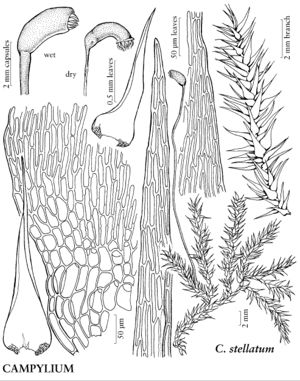Campylium
J. Linn. Soc., Bot. 12: 631. 1869.
| Taxon | Illustrator ⠉ | |
|---|---|---|
 | Campylium stellatum | Patricia M. Eckel |
Plants small or medium-sized, green, yellowish green, golden brown, golden yellow, or brownish. Stems unbranched, irregularly branched, or irregularly pinnate; hyalodermis absent, central strand absent; paraphyllia absent or sometimes present; rhizoids or rhizoid initials on stem or abaxial costa insertion, rarely forming tomentum, slightly or strongly branched, smooth or slightly warty-papillose; axillary hair distal cells 1–5, hyaline. Stem-leaves erect, spreading, or ± squarrose, occasionally distinctly falcate-secund, cordate, cordate-ovate, ovate, or rounded-triangular, not plicate, 1–4.6 mm; base not or hardly decurrent; margins plane, entire or slightly sinuate, limbidia absent; apex acuminate, acumen differentiated or not, furrowed; costa double or single, ending below mid leaf; alar cells differentiated, rectangular, quadrate, or sometimes transversely rectangular or short-rectangular, strongly inflated, hyaline, widest cells 17–30 µm wide, region distinct, quadrate, broadly ovate, ovate, or rectangular, along basal margins, reaching from margin 15–60% distance to costa at insertion; medial laminal cells linear, rarely shortly so; marginal cells 1-stratose. Sexual condition dioicous or autoicous. Capsule horizontal, cylindric, curved; peristome perfect; exostome margins dentate or slightly dentate distally; endostome cilia usually 1–3, well developed, nodulose. Spores (10–) 11–24 µm.
Distribution
North America, Mexico, West Indies (Haiti), Central America (Guatemala), Eurasia, Pacific Islands (New Zealand)
Discussion
Species 4 (4 in the flora).
Campylium occurs in more or less mineral-rich wetlands that are mostly permanently wet or moist. Differences between members of this genus and those of 6. Campyliadelphus and 18. Campylophyllum are discussed with the latter two genera. Members of Drepanocladus with similarly oriented leaves have transversely triangular alar groups that extend from the margin 60–100% of the distance to the costa at the insertion. Other species of Drepanocladus may have approximately quadrate alar groups, but not ovate or rectangular and extending up the leaf margin as in Campylium. The typification of Campylium was discussed by P. Isoviita and L. Hedenäs (1997).
Selected References
None.
Key
| 1 | Sexual condition autoicous; stem leaves erect or spreading; bases subsheathing, broadly cordate-ovate, ovate, or narrowly ovate; acumina when differentiated constituting at most 33% leaf length | > 2 |
| 1 | Sexual condition dioicous; stem leaves spreading or ± squarrose; bases erect to erect-spreading, cordate or rounded-triangular; acumina frequently differentiated, constituting (33-)40-77% leaf length | > 3 |
| 2 | Stem leaves slightly concave, 1.8-2.4 mm; bases ± broadly cordate-ovate; leaves gradually narrowed to apex; acumina not differentiated. | Campylium laxifolium |
| 2 | Stem leaves concave or strongly so, 2.1-4.6 mm; bases ovate or narrowly ovate; leaves ± suddenly or more gradually narrowed to apex; acumina frequently differentiated. | Campylium longicuspis |
| 3 | Stems erect, irregularly branched or sometimes irregularly pinnate; stem leaves 1.7-2.8 × 0.7-1.2 mm; acumina constituting 40-65% (rarely 33-40% in Arctic plants) leaf length; paraphyllia absent. | Campylium stellatum |
| 3 | Stems creeping, irregularly pinnate; stem leaves 1-2.3 × 0.4-1 mm; acumina constituting 55-77% leaf length; paraphyllia sometimes present. | Campylium protensum |
"narrower" is not a number.